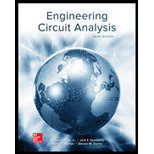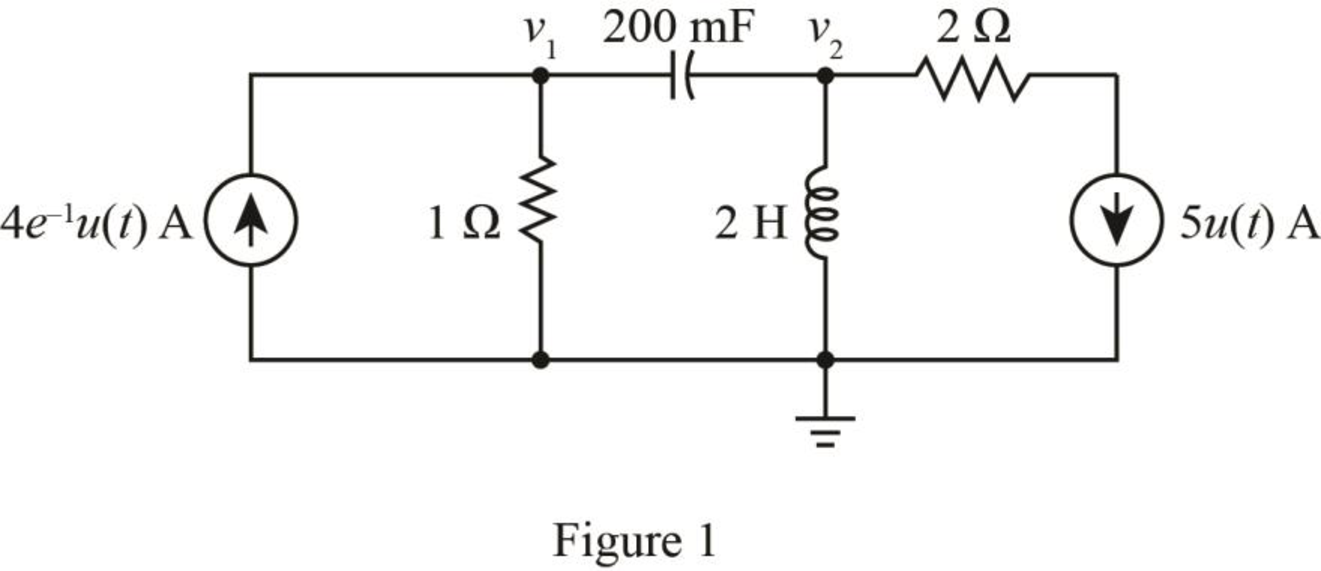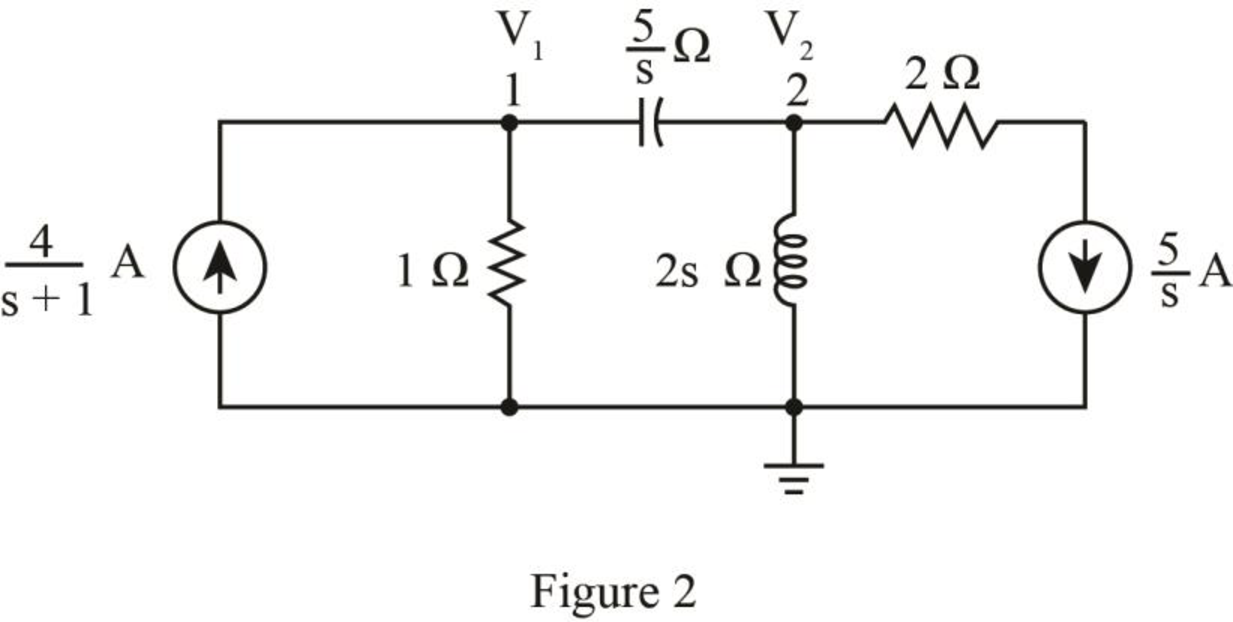
Concept explainers
The power dissipated by the
Answer to Problem 60E
The power dissipated by the
Explanation of Solution
Given data:
The required diagram is shown in Figure 1.

Calculation:
The conversion of
Hence, the conversion of
The
The Laplace transform of
The Laplace transform of
The required diagram for the

Apply nodal analysis at node 1 and the expression is written as,
Apply nodal analysis at node 2 and the expression is written as,
Solve equation (1) and (2) by Cramer’s rule and it is written as,
Further simplify the above expression.
Further simplify the above expression by taking partial fractions.
The Laplace transform of
The Laplace transform of
The properties for Laplace transform are written as,
The inverse Laplace of the given function is written as,
Substitute
The power dissipated in
Here,
Substitute
Conclusion:
Therefore, the power dissipated by the
Want to see more full solutions like this?
Chapter 14 Solutions
Engineering Circuit Analysis
- Find the transfer function θ1/T and θ2/T Where, K= 2+c D1 = 1 , D2 = 5 J1=3+a, J2= 2+b The values are a=4, b=1, c=5arrow_forwardSubject: Engineering Analysis (Laplace Transform) Typical solution pleasearrow_forwardSignal and system The mathematical model of a system is y" (t) + ay'(t) + by(t) = a (t) + ca (t) where a=1, b=2 and c=1. 1) Find zeros and poles of the system. 2) Show them onto the S-Plane (the complex plane) 3) Discuss the BIBO stability of the system.arrow_forward
- The dynamics of a system is derived from the inverse Laplace transform of X(s) = (s + 3) / (s)(s + 5) , determine the equation that defines X(t)?arrow_forwardUsing Laplace, what is the output current i(t) at 0<t<15 given that i(t) at t<0 is 0A?arrow_forward(Signals and Systems) Determine whether the systems with these transfer functions are stable, marginally stable or unstable by determining the poles.arrow_forward
- An 2 kΩ resistor, a 6.25 H inductor, and a 250 nF capacitor are inparallel. Express the s-domain impedance of this parallel combination asa rational function.arrow_forwardUsing the laplacetransformation table, evaluate the following, considering any other variableother than t as constant unless otherwise stated: e. L[t sin 3t]f. L[e^ln e^2t]arrow_forwardA 400 Ω resistor, a 2.5 mH inductor, and a 40 nF capacitor are inseries. Express the s-domain impedance of this series combination as arational function.arrow_forward
- Suppose an LTI system has impulse response h(t)=u(t+1)−u(t−1),and input x(t)=t[u(t−1)−u(t−6)]. Use graphical convolution method to determine the zero-state response. Do not use Laplace transformarrow_forwardObtain the transfer function of the given electrical system below expressed in Laplace form s . Let i(t) be the input of the system and the voltage across R4 be the output of the system.arrow_forwardA series circuit of 27 ohms, 3.06 Henry Inductor and 0.0172 capacitor are energized by 700 Volts DC supply. Determine the expression of current using Laplace transform. Solve also for the time where current is maximum.PLASE WRITE YOUR SOLUTION CLEARLY AND COMPLETE, THANKSarrow_forward
 Introductory Circuit Analysis (13th Edition)Electrical EngineeringISBN:9780133923605Author:Robert L. BoylestadPublisher:PEARSON
Introductory Circuit Analysis (13th Edition)Electrical EngineeringISBN:9780133923605Author:Robert L. BoylestadPublisher:PEARSON Delmar's Standard Textbook Of ElectricityElectrical EngineeringISBN:9781337900348Author:Stephen L. HermanPublisher:Cengage Learning
Delmar's Standard Textbook Of ElectricityElectrical EngineeringISBN:9781337900348Author:Stephen L. HermanPublisher:Cengage Learning Programmable Logic ControllersElectrical EngineeringISBN:9780073373843Author:Frank D. PetruzellaPublisher:McGraw-Hill Education
Programmable Logic ControllersElectrical EngineeringISBN:9780073373843Author:Frank D. PetruzellaPublisher:McGraw-Hill Education Fundamentals of Electric CircuitsElectrical EngineeringISBN:9780078028229Author:Charles K Alexander, Matthew SadikuPublisher:McGraw-Hill Education
Fundamentals of Electric CircuitsElectrical EngineeringISBN:9780078028229Author:Charles K Alexander, Matthew SadikuPublisher:McGraw-Hill Education Electric Circuits. (11th Edition)Electrical EngineeringISBN:9780134746968Author:James W. Nilsson, Susan RiedelPublisher:PEARSON
Electric Circuits. (11th Edition)Electrical EngineeringISBN:9780134746968Author:James W. Nilsson, Susan RiedelPublisher:PEARSON Engineering ElectromagneticsElectrical EngineeringISBN:9780078028151Author:Hayt, William H. (william Hart), Jr, BUCK, John A.Publisher:Mcgraw-hill Education,
Engineering ElectromagneticsElectrical EngineeringISBN:9780078028151Author:Hayt, William H. (william Hart), Jr, BUCK, John A.Publisher:Mcgraw-hill Education,





